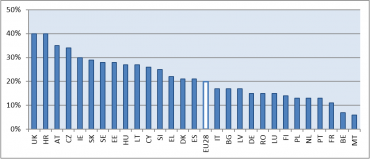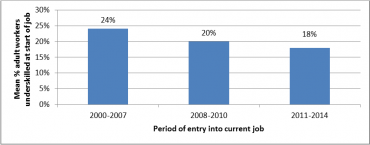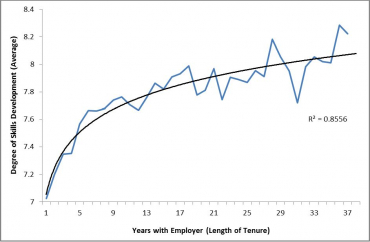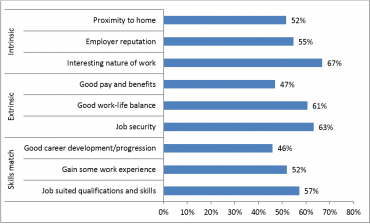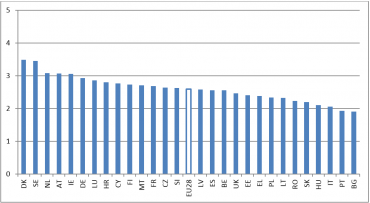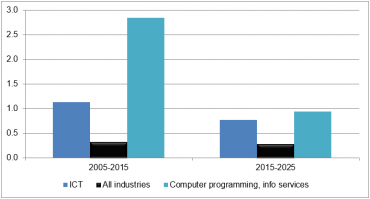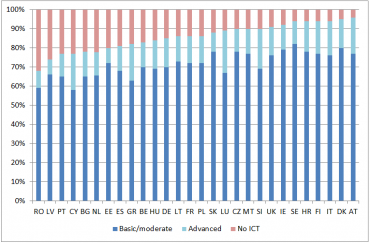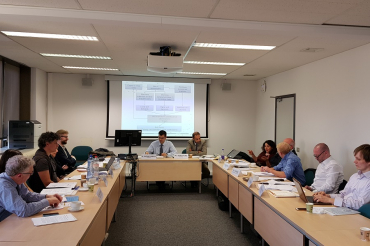Cedefop’s European skills and jobs survey (ESJ survey) data show that one in five young Europeans are employed in jobs that require a lower level of qualifications than the one possessed (the so-called overeducated). Cedefop expert @ilias_livanos notes, however, that just as important is the phenomenon of underskilling or skill gaps. These arise when employees’ skills are lower than those required to perform their job. In particular, Cedefop’s ESJ survey reveals that one in five Europeans are underskilled at the time of hiring and that mitigating such skill gaps requires continuing formal and informal learning in the workplace.
1.1 Back to the future Part II
Having time-travelled from distant 1985 back to recent 2015, Marty McFly found himself providing shelter and financially supporting his grown-up son, Jack. Jack had been trapped in the downturn of an economy, where almost one in five young European employees were employed in jobs that required lower qualifications than their own [1].
‘How unfair!’ he thought. How can this compare with his own adolescence? At that time he could rest assured that his own graduate degree was enough to secure him not only financial independence but also a bright future.
Being taken aback, Marty started reading various studies to understand what could possibly have gone wrong with the educational choices they made together with his son. It was not long until a Cedefop headline made him go cross-eyed: ‘One in five EU workers lack the skills required to do their job when hired.’
‘It cannot be,’ he whispered, ‘something must have gone wrong, if only we knew back then what good educational choices are.’ Marty then decides to reignite the famous Delorean, and time travels back to 1955, so that he and his son have a second chance in selecting a university course. But this time round he has an unfair advantage – he has in his hands new data on skill mismatches and labour market trends from Cedefop’s European skills and jobs survey [2] and the European Union’s new web portal – the Skills Panorama [3].
1.2 Skills at the time of hiring lag behind jobs’ content
While the academic literature around skills mismatches is mostly centred on the phenomenon of ‘overeducation’ or ‘underutilisation of skills’ of graduates [4], an equally pervasive aspect of skills mismatches, and typically one of most concern for policy-making, is that of ‘underskilling’. The latter is defined as a situation where existing workers find their skills challenged by the work content calling, thus, for further vocational training [5].
At first sight, one may think that such a phenomenon is of limited importance given than training and development of skills typically takes place at the workplace, while individuals who find themselves in this situation have already secured employment. Nevertheless, one needs to consider the implications for both the economy and the individuals as, on the one hand, underskilling may lower overall productivity for firms while, on the other hand, individuals may see this back-firing on their wages and career development prospects, including an increased risk of skills obsolescence and subsequent job-loss. Cedefop’s ESJ survey, for instance, confirms that 33% of under-skilled employees think their skills are likely or very likely to become outdated in the next five years, while the corresponding percentage for those with sufficient skills for their jobs is only 20% (Cedefop, 2015a).
From the side of firms, finding employees whose skills are fully matched to the requirements of the jobs seems to be a challenging task. According to the ESJ survey 5% of EU employees in 2014 described their skills as being lower to those required to do their current jobs. However, the ESJ survey was also unique in that it asked employees to assess the match of their skills with what was needed by their job when they were recruited – providing us with an indication of skills mismatches at the time when people engage in labour market mobility. At the time of hiring the share of employees with skills lower than those needed by the job was found to be much greater – about 22% of EU employees considered themselves as being underskilled (Figure 1). Employees in the Baltics, in particular, are the most likely to experience, during the recruitment phase, a mismatch between their skills and those needed by their jobs.
1.3 Rethinking underskilling
Understanding the reasons behind underskilling is necessary especially at times when a large part of employees see their levels of education and qualifications being higher than those needed by their job (i.e. are ‘overeducated’).
There are three dominant theories that can be used to conceptualise the underskilling phenomenon:
Figure 1: Share of EU adult workers who thought their skills were lower than required by their job at the start of their current jobs, 2014, EU28

Source: Livanos, I. and I. Nunez (2015); assessed via http://skillspanorama.cedefop.europa.eu/en/datasets
The first one relates to the insufficient information signals that employers may have about the candidates at the time of hiring. For example, a certain educational degree, studies on a specific academic field or even from a particular educational institution do not always provide the perfect signal and employers may only later come to realise that the skills of their preferred candidate are actually lower than those required.
The second reason sees under-skilling as an outcome of the inability/difficulty employers have in attracting workers with adequate skills and capabilities, also related to the business cycle. In other words, under-skilling may reflect skill shortages in the economy, where the existing workforce lacks certain skills when hired but perhaps is able to do the job at a minimum level required. This can be particularly pronounced during periods of economic booms. Firms and workers then have to invest in the professional development of their workforce over time to mitigate any such initial underskilling. Nonetheless, one cannot discount the fact that such a situation could also be attributed to bad quality jobs or unattractive working conditions that make it difficult for employers to attract workers with the right skills.
Finally, the selection of ‘underskilled’ candidates may be a part of firms’ hiring practices that find it cheaper to hire candidates with lower skills than required, and then invest in certain training programmes and on-the-job training in order to bring their employees’skills up-to-speed. This situation will, of course, vary depending on the extent to which the productive processes of firms rely on specific types and fields of education. In other words, firms may prefer to use other mechanisms, such as the adoption of a probationary period of employees’ performance, rather than that of screening at the time of recruitment.
1.4 What triggers underskilling?
The recent availability of Cedefop’s ESJ survey allows us to delve deeper into the factors associated with higher changes of workers being under-skilled when hired.
Focusing on the level of education it is evident that university graduates have lower chances of finding themselves trapped in under-skilling, thus higher education could be seen as an effective mechanism for reducing such a phenomenon. However, differences in rates of underskilling also exist among tertiary graduates, related to the specific subject or field of their studies (Figure 2). Although differences are not very wide, one can isolate two particular cases. The first is that of Mathematics and Statistics which has the lowest percentage of under-skilling, signalling that graduates of such schools are able to adjust to the skill needs of their jobs without great difficulty. On the opposite side, however, it cannot go without noticing that graduates from Medicine and Health-related disciplines have among the highest underskilling rates. However, this could be justified by the ever changing skills context of such professions due to the advancement of new technologies, working methods and techniques.
Different groups of workers may experience different levels of underskilling while in many cases differences may also be country specific. In general, Figure 3 shows that underskilling affects mostly female workers, who may experience extended periods outside of the labour market and face greater skills challenges during their labour market reintegration. It is more prominent among younger cohorts (e.g. 24-39), who lack valuable work experiences and knowledge of the workings of the labour market, while it is also higher in sectors that employ, on average, workers with lower levels of education, such as construction, manufacturing or the primary sector and utilities. In particular, in these sectors underskilling often exceeds 35% of the workforce. This suggests that the nature and growth of skill needs in sectors that traditionally employ(ed) lower-educated workers is changing fast, posing a significant need for continuing vocational training of such vulnerable workers.
Figure 2: Graduate underskilling in the EU across fields of study, 2014, EU28

Source: Livanos, I. and I. Nunez (2015)
The state of the labour market is also a significant trigger of underskilling. In particular, in instances where workers had the ‘luxury’ to turn down job offers, their chances of underskilling were significantly lower relative to workers who were left with no alternative but to accept the offered job. On a similar vein, entering a job after experiencing a spell of unemployment is also associated with higher chances of underskilling at hiring. This is particularly promiment for the very long-term unemployed, namely those who had been looking for a job for more than two years prior to taking up their current post.
Finally, non-formal and informal training can have a marked impact in terms of avoiding the under-skilling of employees. Underskilling is more evident in firms where training takes place in the form of learning-by-doing (e.g. learning from colleagues or a supervisor), which confirms that companies that hire under-skilled workers are more likely to invest in their further skill development.
1.5 What triggers underskilling?
The academic discourse tends to focus on the problem of overeducation and for very good reasons, given that such workers often get stuck in dead-end jobs or get penalised in terms of their wages and job satisfaction [6]. But the Cedefop ESJ survey further reveals that about one in five (19%) overeducated workers simultaneously lack the skills that their job needs when hired or admit to having lower skills than needed to be fully proficient in their jobs (i.e. they suffer from skill gaps). This highlights that for a small subgroup of workers ‘being overeducated does not necessarily mean they are overskilled.’
The phenomenon of underskilling after recruitment impacts a similar share of the EU adult workforce and affects to a greater extent certain groups of ‘vulnerable’ workers, such as younger individuals, females and medium-educated workers. European skills policy thus needs to focus its attention to providing up-skilling opportunities to these groups of employees.
For instance, education and training policies should continue to pay attention to low and middle skilled workers to provide them with the necessary traning options, including relevant vocational education and training (VET) courses. Moreover, even though the impact of the state of the economy on the chances of underskilling seem clear-cut, this can be mitigated, for example, if at the time of unemployment/job search the appropriate training courses are offered to job seekers so as to enhance their skills.
Finally, the variation of underskilling across fields of studies of graduates calls for the potential intervention of policy makers. In particular, higher levels of underskilling in sensitive professions, such as those related to health and medicine studies, require from education providers to continue to ensure that workers’ skills stay up-to-date while employers also have to remain alert to the need to offer further vocational training.
Figure 3: Probability of underskilling when hired across various groups of workers in EU, 2014, EU28

Source: Livanos, I. and I. Nunez (2015)
Enter the debate on the policy implications of the ESJ survey at: twitter.com/cedefop #ESJsurvey or facebook.com/Cedefop
Further information about the survey on Cedefop’s website.
Or contact: Konstantinos.Pouliakas@cedefop.europa.eu
Discover more ESJ survey indicators and analysis at Skills Panorama website.
Please cite as: Cedefop (2016), ‘EU workforce: overeducated yet underskilled?’, #ESJsurvey Insights, No 7, Thessaloniki: Greece.
Further reading:
Cedefop (2010) The skills matching challenge http://www.cedefop.europa.eu/en/publications-and-resources/publications/3056
Cedefop (2015a) Skills, qualifications and jobs: the making of a perfect match? Evidence from Cedefop’s European skills and jobs (ESJ) survey http://www.cedefop.europa.eu/en/publications-and-resources/publications/3072
Cedefop #ESJsurvey INSIGHT No 2 (2015b), Mitigating overqualification in the EU - http://www.cedefop.europa.eu/en/news-and-press/news/esjsurvey-insights-mitigating-overqualification-eu
Livanos, I. and I. Nunez, ‘Rethinking under-skilling: evidence from the Cedefop European skills and jobs survey,’ research paper presented at the Cedefop/IZA workshop on skills and skill mismatch, 29-30 November 2015, Thessaloniki: http://www.iza.org/conference_files/2015_Skill_Mismatch/livanos_i5629.pdf
McGuinness, S. and Ortiz, L. (2016). ‘Skill gaps in the workplace: Measurement, determinants and impacts,’ Industrial Relations Journal, 47(3): 253-278.
McGuinness, S. and Pouliakas, K. (2016), ‘Deconstructing theories of overeducation in Europe: a wage decomposition approach,’ IZA Discussion Paper, No 9698: http://ftp.iza.org/dp9698.pdf
References:
[1] See Cedefop’s ESJ Insight (2015b), Mitigating over-qualification in the EU - http://www.cedefop.europa.eu/en/news-and-press/news/esjsurvey-insights-mitigating-overqualification-eu
[2] Cedefop (2015a) - http://www.cedefop.europa.eu/en/events-and-projects/projects/analysing-skill-mismatch
[3] http://skillspanorama.cedefop.europa.eu/en
[4] McGuinness, S. and Pouliakas. K. (2016) ‘Deconstructing theories of overeducation in Europe’
[5] Underskilling of employees should not be confused with skill shortages, the inability of employers to find the right skills among job applicants, or a lack of appropriate skills by the unemployed. Being under-skilled is sometimes considered a similar type of mismatch as that of a ‘skill gap’ expressed by employers, although the latter are usually expressed with regards to a desired level of proficiency that the workforce should have in carrying out their job tasks (McGuinness and Ortiz, 2016). If confused regarding skill mismatch terminology, see Cedefop (2010).
Data insights details
Downloads
#ESJsurvey INSIGHTS No 7 - EU workforce: overeducated yet underskilled?

